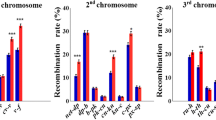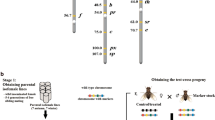Summary
Divergent directional selection lines were initiated from base populations founded from parents taken from different parts of the sternopleural chaetae distribution in a cage population of Drosophila melanogaster. Lines founded from parents taken from the central part of the distribution showed greater response and higher realised heritability than lines derived from parents with extreme high or extreme low chaetae number. The results suggest that centrally derived phenotypes have higher heterozygosity for chaetae factors than extreme phenotypes and that these factors have a large effect on the character.
Similar content being viewed by others
References
Barnes BW (1968) Stabilising selection in Drosophila melanogaster. Heredity 23:433–442
Beardmore JA, Shami SA (1979) Heterozygosity and the optimum phenotype under stabilising selection. Aquilo Ser Zool 20:100–110
Bowman JC, Falconer DS (1960) Inbreeding depression and heterosis of litter size in mice. Genet Res 1:262–274
Bulmer MG (1980) The mathematical theory of quantitative genetics. Oxford University Press, Oxford
Clayton GA, Morris JA, Robertson A (1957) An experimental check on quantitative genetical theory. 1. Short-term responses to selection. J Genet 55:131–151
Falconer DS (1981) Introduction to quantitative genetics, 2nd edn. Longman, New York
Frankham R, Jones LP, Barker JSF (1968) The effects of population size and selection intensity in selection for a quantitative character in Drosophila. 1. Short-term responses to selection. Genet Res 12:237–248
Gibson JB, Bradley BP (1974) Stabilising selection in constant and fluctuating environments. Heredity 33:293–302
Gibson JB, Thoday JM (1962) Effects of disruptive selection. 6. A second chromosome polymorphism. Heredity 17:1–26
Goodwill R (1974) Comparison of three selection programs using Tribolium castaneum. J Hered 65:8–14
Hollingdale B (1971) Analyses of some genes from abdominal bristle number selection lines of Drosophila melanogaster. Theor Appl Genet 41:292–301
Katz AJ, Young SS (1975) Selection for high adult body weight in Drosophila populations with different structures. Genetics 81:163–175
Kearsey MJ, Barnes BW (1970) Variation for metrical characters in Drosophila populations. 2. Natural selection. Heredity 25:11–21
Lande R (1976) the maintenance of genetic variability by mutation in a polygenic character with linked loci. Genet Res 26:221–235
Lande R (1983) The response to selection on major and minor mutations affecting a metrical trait. Heredity 50:47–65
Latter (1960) Natural selection for an intermediate optimum. Aust J Biol Sci 13:30–35
Lerner IM (1954) Genetic homeostatis. Oliver and Boyed, Edinburgh
Lewontin RC (1964) The interaction of selection and linkage. 2. Optimum models. Genetics 50:757–782
Lewontin RC (1974) The genetic basis of evolutionary change. Columbia University Press, New York
Madalena FE, Robertson A (1975) Population structure in artificial selection: Studies with Drosophila melanogaster. Genet Res 24:113–126
Mather K (1941) Variation and selection of polygenic characters. J Genet 41:159–193
Mather K, Harrison BJ (1949) The manifold effect of selection. Heredity 3:1–52
Mittler S, Bennet J (1962) A simple food medium that requires no live yeast with the minimum of variables. Dros Inf Serv 36:131–132
Prout T (1962) The effects of stabilising selection on the time of development in Drosophila melanogaster. Genet Res 3:364–382
Rathie KA, Nicholas FW (1980) Artificial selection with differing population structures. Genet Res 36:117–131
Robertson A (1960) A theory of limits in artificial selection. Proc R Soc London Ser B 153:234–249
Robertson A (1977) Artificial selection with a large number of linked loci. In: Pollak E, Kempthorne O, Bailey TB (eds) Proc Int Conf Quant Genet, Iowa State University Press, Ames, pp 307–322
Scharloo W (1964) The effects of disruptive and stabilising selection on the expression of a cubitus interruptus mutant in Drosophila. Genetics 50:553–552
Serra L, Oller JM (1984) Analysis of allozymic and quantitative variation produced by artificial selection in Drosophila melanogaster. Genetica 63:39–47
Shereif NAK, Skibinski DOF (1988a) Association of allozyme heterozygosity and sternopleural chaetae number in Drosophila melanogaster. Genetica 76:209–217
Shereif NAK, Skibinski DOF (1988b) Stabilising selection on three chaetae characters in Drosophila melanogaster. Heredity 60:427–433
Skibinski DOF, Thoday JM (1979) Disruptive selection with fixed optima. Heredity 42:327–335
Sokal RS, Rohlf FJ (1981) Biometry, 2nd edn. Freeman, San Francisco/CA
Thoday JM (1959) Effects of disruptive selection. 1. Genetic flexibility. Heredity 13:187–203
Thoday JM, Gibson JB (1972) A simple test for stabilising and disruptive selection. Egypt J Genet Cytol 1:47–50
Thoday JM, Gibson JB, Spickett SG (1964) Regular responses to selection. 2. Recombination and accelerated response. Genet Res 5:1–19
Thompson JN, Thoday JM (1979) Quantitative genetic variation. Academic Press, New York
Turelli M (1984) Heritable genetic variation via mutation-selection balance: Lerch's zeta meets the abdominal bristle. Theor Popul Biol 25:138–193
Turelli M, Ginzburg LR (1983) Should individual fitness increase with heterozygosity? Genetics 104:191–209
Wright S (1935) The analysis of variance and correlations between relatives with respect to deviations from an optimum. J Genet 30:243–294
Wright S (1978) The relation of livestock breeding to theories of evolution. J Anim Sci 46:1192–1200
Yousif ME, Skibinski DOF (1982) Directional-disruptive selection in Drosophila melanogaster. Herdity 49:71–79
Author information
Authors and Affiliations
Additional information
Communicated by F. Mechelke
Rights and permissions
About this article
Cite this article
Skibinski, D.O.F., Shereif, N.A.K. Directional selection in lines founded from different parts of the phenotypic distribution of sternopleural chaetae number in Drosophila melanogaster . Theoret. Appl. Genetics 77, 409–415 (1989). https://doi.org/10.1007/BF00305837
Received:
Accepted:
Issue Date:
DOI: https://doi.org/10.1007/BF00305837




